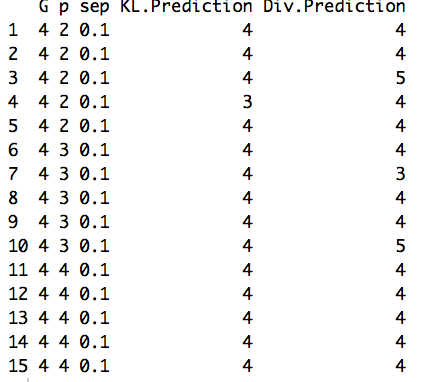I am creating a dataframe with data from runs of my program. I specify G, p, sep as my parameters, and then I have the prediction for G in my KL.Prediction column.

What I want to do is aggregate the predictions so I would have a table or dataframe or something showing that, for example, for G=4, p=2, sep=0.1, it predicted G=4, 4 times, and G=3, once. For G=4, p=3, sep=.1, it predicted G=4, 5 times, etc.
It would be easier to help you if you provide sample data on a copy/paste friendly format (a screenshot of your data is not very useful), check out this blog post by Mara that shows how to do it.
1 Like
Looks like you just want to group and count. Let me make this a reprex for you:
library(tidyverse)
n <- 500
df <- data.frame(
G = sample(3:4, n, TRUE),
p = sample(5:6, n, TRUE),
sep = sample(c(.1, .2), n, TRUE),
kl = sample(3:5, n, TRUE),
div = sample(7:8, n, TRUE)
)
df %>%
group_by(G, p, sep, kl, div) %>%
summarize(count = n())
#> # A tibble: 48 x 6
#> # Groups: G, p, sep, kl [?]
#> G p sep kl div count
#> <int> <int> <dbl> <int> <int> <int>
#> 1 3 5 0.1 3 7 5
#> 2 3 5 0.1 3 8 11
#> 3 3 5 0.1 4 7 13
#> 4 3 5 0.1 4 8 11
#> 5 3 5 0.1 5 7 9
#> 6 3 5 0.1 5 8 11
#> 7 3 5 0.2 3 7 12
#> 8 3 5 0.2 3 8 13
#> 9 3 5 0.2 4 7 14
#> 10 3 5 0.2 4 8 9
#> # … with 38 more rows
Created on 2019-02-09 by the reprex package (v0.2.1)
So in the example above, G=3, p=5, sep=0.1, kl=3, and div=7 occurred 5 times.
Is this what you were after?
2 Likes
Thank you very much! It did exactly what I needed.
1 Like
This topic was automatically closed 7 days after the last reply. New replies are no longer allowed.
If you have a query related to it or one of the replies, start a new topic and refer back with a link.